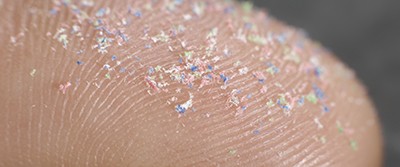New Ways to Target Microplastic Pollution

By Kylie Wolfe
Plastic is all around us. It's in every aisle of the grocery store in the form of water bottles, bags, and packaging — and it's in our skincare products and toothpaste, too.
According to the article “Production, use, and fate of all plastics ever made,” published in Science Advances, people recycle only nine percent of the plastic they use. The rest ends up in landfills or tossed along roads and rivers, ultimately taken up by the environment. With time, plastic breaks down into tiny pieces known as microplastics.
The Plastic Problem
Microplastics aren't new. Researchers started investigating them in the 1970s and hundreds of studies have followed. Mistaken for food, microplastics are consumed by fish, birds, and other animals, but they don't provide the nutrients they need to survive.
Because microplastics end up in our food and water sources, it’s easy to imagine ingesting them without realizing it. Recent estimates suggest that Americans consume 70,000 bits of plastic each year. These findings were published in Environmental Science & Technology last June.
It’s unknown how long it takes for microplastics to travel through our bodies once they’re consumed, but the longer they’re inside us, the greater the exposure and risk. Ingredients in some plastics can cause cancer or changes to hormone levels.
Plastic Alternatives
Minimizing plastic pollution could be as simple as not buying single-use plastics, including products packaged in it. Ask yourself if the item is essential. Do you need straws or plastic bags? If not, don’t buy or use them.
Researchers are also looking into other alternatives, like biodegradable plastics. Traditional plastics take a long time to break down and biodegradable ones could take less. Biodegradable plastics are eaten by microbes, but only at high temperatures. They can also be mistaken for regular plastic and not properly recycled, so they aren’t perfect.
Special Filters
A team at the University of Toronto is testing a washing machine filter that can collect microplastics and prevent them from going down the drain, according to their work in Marine Pollution Bulletin. When clothes tumble through a washing machine, they produce lint. Clothes made of nylon, polyester, or polyethylene release plastic particles.
Water treatment plants aren't designed to remove microplastics, so they end up in local water sources. Ideally, we would stop manufacturing plastic-based clothing, but recent tests have shown that the researchers' washing machine filters remove around 90 percent of microfibers. For the time being, filtering out harmful particles from our wash cycles is a more practical way to protect ourselves and the environment from these pollutants.
New Technologies
What about existing microplastic pollution? Researchers in Australia came up with a potential solution, publishing their findings in Matter last July. They designed nano-sized, spiral tubes made of carbon with a nitrogen coating. When mixed with peroxymonosulfate (POMS), they create new chemicals called reactive oxygen species that break down microplastics even further.
The team, led by Jian Kang, chemical engineer at Curtin University, found that they were able to reduce the amount of microplastics in the water between one third and one half. Though early tests seem promising, there’s still a lot to learn about the process and its viability.
Shaping Our Future
While scientists look for alternatives, and ways to filter out microplastics and clean up existing pollutants, it’s important to also consider our plastic use as a society. By avoiding single-use plastics and opting for more reusable and sustainable options, everyone can do their part to minimize plastic pollution.
Discussion Questions
- How can you decrease the amount of plastic you use each day?
- What can we do as a society to minimize plastic waste and pollution?
Vocabulary
- Biodegradable
- Microplastic
- Pollution